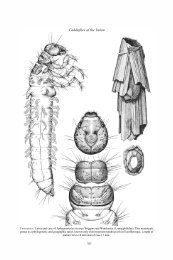PDF 29.6 MB - Department of Biological Sciences
PDF 29.6 MB - Department of Biological Sciences
PDF 29.6 MB - Department of Biological Sciences
You also want an ePaper? Increase the reach of your titles
YUMPU automatically turns print PDFs into web optimized ePapers that Google loves.
Canadian Journal <strong>of</strong> Arthropod Identification No. 15 (May 2011) JACKSON ET AL.<br />
Materials and Methods<br />
Morphological Work<br />
Character photos were taken using a<br />
Microptics Digital Lab XLT imaging system<br />
utilizing a Canon EOS 1 Ds camera and Microptics<br />
ML-1000 flash fibre optic illumination system.<br />
The computer freeware CombineZ (http://www.<br />
hadleyweb.pwp.blueyonder.co.uk/CZ5/combinez5.<br />
htm) was used to combine multiple photos taken at<br />
different focal points into high-resolution images.<br />
Pinned specimen habitus shots, plates and some<br />
character shots were taken using a Nikon D70s<br />
digital camera, a Nikkor 105mm Macro lens, and a<br />
Nikon SB800 flash unit. Live habitus photographs<br />
were taken using Nikon D70 or D2X cameras, with<br />
105mm or 60mm lenses and various flash<br />
combinations. Photos were processed using Adobe<br />
Photoshop CS3 (AP CS3) for Windows; the online<br />
web pages were designed and built in Micros<strong>of</strong>t<br />
Powerpoint 2003. Further work on the web pages<br />
was done using Adobe Fireworks and Adobe<br />
Dreamweaver.<br />
Most specimens used in pinned habitus shots<br />
are from the University <strong>of</strong> Guelph Insect<br />
Collection, although some specimen photos were<br />
<strong>of</strong> specimens borrowed from the CNCI and LEM.<br />
Specimens used for photos have been labeled<br />
accordingly and deposited.<br />
Genetic Analysis<br />
Total genomic DNA was extracted from a<br />
single leg according to the protocol developed by<br />
Ivanova et al. (2006). A 658-bp region near the 5<br />
terminus <strong>of</strong> the CO1 gene was amplified using<br />
primers LepF1 5' ATTCAACCAATCATAAAGA<br />
TATTGG-3 and LepR1 5'TAAACTTCTGGATGT<br />
CCAAAAAATCA-3.<br />
PCRs were carried out in 96-well plates in<br />
12.5- l reaction volumes containing 2.5 mM<br />
MgCl2, 5 pmol <strong>of</strong> each primer, 20 M dNTPs, 10<br />
mM Tris HCl (pH 8.3), 50 mM KCl, 10–20 ng (1–<br />
2 l) <strong>of</strong> genomic DNA, and 1 unit <strong>of</strong> TaqDNA<br />
polymerase using a thermocycling pr<strong>of</strong>ile <strong>of</strong> one<br />
cycle <strong>of</strong> 2 min at 94°C; five cycles <strong>of</strong> 40 sec at<br />
94°C, 40 sec at 45°C, and 1 min at 72°C; followed<br />
by 35 cycles <strong>of</strong> 40 sec at 94°C, 40 sec at 51°C, and<br />
1 min at 72°C, with a final step <strong>of</strong> 5 min at 72°C.<br />
Products were visualized on a 2% agarose E-Gel<br />
96-well system (Invitrogen), and samples<br />
containing clean single bands were bidirectionally<br />
sequenced by using BIGDYE 3.1 on an ABI 3730<br />
DNA Analyzer (Applied Biosystems). Contigs<br />
were assembled by using SEQUENCHER 4.0.5<br />
(Gene Codes).<br />
Sequences, trace files, and field data are<br />
available in the Teph (file name) file in the<br />
Completed Projects section <strong>of</strong> the Barcode <strong>of</strong> Life<br />
Database (BOLD; www.barcodinglife.org;<br />
Ratnasingham and Hebert, 2007). Additional<br />
collection information is deposited in the<br />
University <strong>of</strong> Guelph Insect Collection Database<br />
and all sequences have been deposited in the<br />
GenBank database (CO1: accession nos.<br />
EU484466–EU484568). Sequence divergences<br />
were calculated by using the K2P distance model<br />
(Kimura, 1980) and an NJ phenogram (Saitou &<br />
Nei, 1987) was created (as implemented in BOLD)<br />
to provide a graphic representation <strong>of</strong> the amongspecies<br />
divergences. A table <strong>of</strong> specimens<br />
sequenced for DNA barcoding has been included<br />
(Appendix).<br />
Checklist <strong>of</strong> Tephritidae species occuring or<br />
likely to occur in Ontario (classification based<br />
on Norrbom et al. 1999)<br />
‡ - New Canadian record<br />
† - New Ontario record<br />
* - Species not yet recorded in Ontario, but likely<br />
to occur<br />
◊ - Species recorded from Ontario since Foote et<br />
al. (1993)<br />
● – Barcode Acquired<br />
Subfamily Trypetinae<br />
Tribe Adramini<br />
Euphranta Loew<br />
Euphranta canadensis (Loew) ●<br />
Tribe Carpomyini<br />
Subtribe Carpomyina<br />
Rhagoletis Loew<br />
Rhagoletis basiola (Osten Sacken) ●<br />
Rhagoletis chionanthi Bush ‡<br />
Rhagoletis cingulata (Loew) ●<br />
Rhagoletis cornivora Bush<br />
Rhagoletis fausta Osten Sacken ●<br />
Rhagoletis juniperina Marcovitch ◊●<br />
Rhagoletis meigenii (Loew) †<br />
Rhagoletis mendax Curran<br />
Rhagoletis pomonella (Walsh) ●<br />
Rhagoletis striatella Wulp ●<br />
Rhagoletis suavis (Loew) ‡●<br />
Rhagoletis tabellaria (Fitch) ●<br />
Rhagoletis zephyria Snow<br />
Rhagoletotrypeta Aczél<br />
Rhagoletotrypeta rohweri Foote ‡●<br />
Zonosemata Benjamin<br />
Zonosemata electa (Say) ●<br />
doi:10.3752/cjai.2011.15 2
















